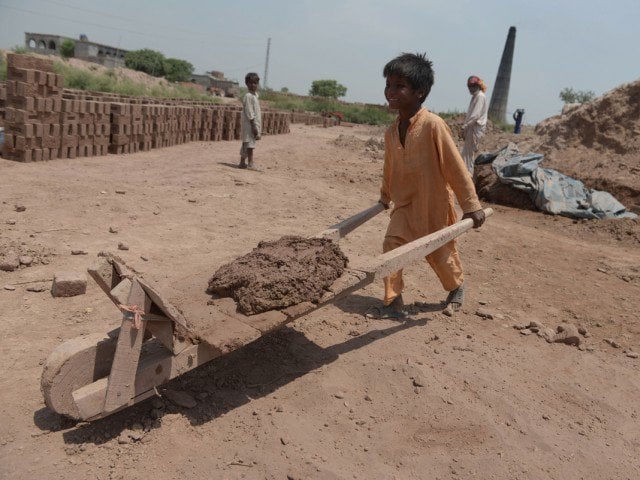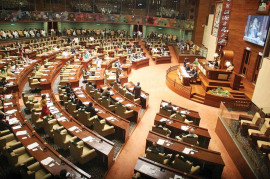
LAHORE: Bonded labour has a sordid history in Punjab’s brick kiln industry. Even though bonded labour was declared illegal 24 years ago, the practice remains impervious to most reform initiatives that have been introduced so far.
This is primarily because previous attempts to reform the industry have failed to address the vicious cycle of poverty that is inherent in the industry. In previous years, bonded labourers have been given respite by freeing them through judicial forums. Such judicial pronouncements, however, have had little effect in curbing the problem.
In this context, unless socio-structural issues causing and sustaining bonded labour in the brick kiln industry are not addressed, any reform initiatives are doomed to fail. The sudden promulgation and enforcement of The Punjab Prohibition of Child Labour at Brick Kilns Ordinance 2016 presents a case in point which is another feeble attempt to liberate bonded labour without doing much to address the socio-structural issues that lie at the root of this problem.
Tainted bricks and govt’s tilt towards Punjab
The Ordinance
It is significant to note that Section 3 of the Ordinance makes it obligatory for all workers engaged at brick kilns to have a written contract with the owner that states the terms and conditions of employment, including the amount of advance (peshgi), the amount of wage and the payback schedule for the advance. Under the Ordinance, a copy of the contract must be submitted before the inspector in charge of the area.
Since most workers at brick kilns are employed on an informal basis, there are, however, multiple issues arising from the legally mandated formalisation of employment.
Firstly, most of the brick kiln workers are illiterate which puts them in a more vulnerable positon vis-à-vis the brick kiln owners when signing a contract. Secondly, the vast powers conferred upon the inspector under the new Ordinance will require a more intricate monitoring system to ensure that inspectors remain objective and not susceptible to corrupt practices.
Likewise, the worker who wants to challenge the terms of his or her employment would now be compelled to use the formal legal system. This would not only put extra financial burden on him or her but also be time-consuming and due to the bonded nature of the labour, become almost impossible.
Without free legal advice and legal infrastructure available to the workers for challenging the contract, and also without vast reforms in the brick industry, this provision will simply become devoid of any meaningful effect.
Similarly, Section 4 limits the advance by taking into consideration two types of employment at the kiln: time-rated workers and piece-rated workers, the latter being those earning per brick. For piece-rated workers, the peshgi cannot exceed the amount of wages for a 6 month period. The time-rated workers cannot receive more than six times of the wage for one wage period.
Education goals: 'Nearly 0.25m more children to be enrolled by 2016'
Most of the workers at the kilns are actually employed on a contractual piece-rate basis which often puts them in danger of having to fulfil unreasonable quotas. That in turn forces them to bring in their whole families to fulfil the daily targets.
The Ordinance also provides that during school hours any child (up to 14 years of age) to be found on the premises of the brick kilns is presumed to be employed there, unless it can be proven otherwise. The full responsibility to prove that a person presumed to be a child is an adult is on the owner and requires a CNIC or a registration certificate (Form-B) or a birth certificate.
It is also important to note that many families reside on the premises of the brick kilns, which makes it difficult to actually differentiate between a child employed in the brick kiln and a child who just happens to live in the vicinity of the brick kiln. This section, thus, paves the way for abuse of governmental power.
Case in point
Consider the events of last Sunday when two children were spotted at a brick kiln near Lahore that led to the arrest of the brick-kiln owner who was booked for a non-bailable offence. In doing so, the government acted by flouting the Ordinance. Since schools are closed on Sunday, the action taken was in contravention of Section 6 and it could not have ben presumed that the children were out of school and hence, employed in the brick kiln.
The events of last Sunday, and those of similar situations that are being widely reported in the media, clearly demonstrate the statutory requirement regarding the presence of any children at brick kilns is ambiguous and gives the government wide-ranging discretionary powers.
Government control
Additionally, while the government’s crackdown against the industry is appreciable, it must remain vigilant and refrain from overstepping its statutory powers. From a practical standpoint, one may also question whether criminalisation of the owners is actually going to end the practice of bonded labour and child labour in the brick industry or whether sealing brick kilns may actually put the workers at more risk as they bear the burden of the kiln’s financial loss?
35 kiln owners arrested, seven houses sealed
Furthermore, it is also worthy to note that the government does not yet have the capacity to actually enforce the scheme and provide quality education to those children. There are no statistics showing how many children taken from brick kilns have actually been rehabilitated and sent to schools. Simply ‘freeing’ children from labour does not solve the structural causes of child labour and the need and relieve pressure to contribute to the family income in poor households.
The writer is the current legal advise-r to the brick kiln association in Pakistan
Published in The Express Tribune, February 8th, 2016.
Like Business on Facebook, follow @TribuneBiz on Twitter to stay informed and join in the conversation.


































































COMMENTS
Comments are moderated and generally will be posted if they are on-topic and not abusive.
For more information, please see our Comments FAQ